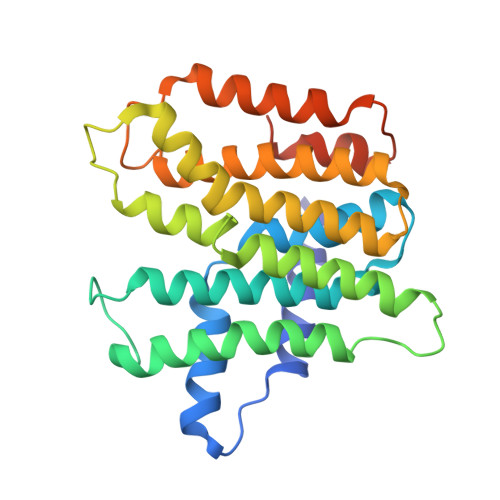Enhanced specificity of mint geranyl pyrophosphate synthase by modifying the R-loop interactions
Hsieh, F.-L., Chang, T.-H., Ko, T.-P., Wang, A.H.-J.(2010) J Mol Biology 404: 859-873
- PubMed: 20965200
- DOI: https://doi.org/10.1016/j.jmb.2010.10.011
- Primary Citation of Related Structures:
3OAB, 3OAC - PubMed Abstract:
Isoprenoids, most of them synthesized by prenyltransferases (PTSs), are a class of important biologically active compounds with diverse functions. The mint geranyl pyrophosphate synthase (GPPS) is a heterotetramer composed of two LSU¡¤SSU (large/small subunit) dimers. In addition to C(10)-GPP, the enzyme also produces geranylgeranyl pyrophosphate (C(20)-GGPP) in vitro, probably because of the conserved active-site structures between the LSU of mint GPPS and the homodimeric GGPP synthase from mustard. By contrast, the SSU lacks the conserved aspartate-rich motifs for catalysis. A major active-site cavity loop in the LSU and other trans-type PTSs is replaced by the regulatory R-loop in the SSU. Only C(10)-GPP, but not C(20)-GGPP, was produced when intersubunit interactions of the R-loop were disrupted by either deletion or multiple point mutations. The structure of the deletion mutant, determined in two different crystal forms, shows an intact (LSU¡¤SSU)(2) heterotetramer, as previously observed in the wild-type enzyme. The active-site of LSU remains largely unaltered, except being slightly more open to the bulk solvent. The R-loop of SSU acts by regulating the product release from LSU, just as does its equivalent loop in a homodimeric PTS, which prevents the early reaction intermediates from escaping the active site of the other subunit. In this way, the product-retaining function of R-loop provides a more stringent control for chain-length determination, complementary to the well-established molecular ruler mechanism. We conclude that the R-loop may be used not only to conserve the GPPS activity but also to produce portions of C(20)-GGPP in mint.
Organizational Affiliation:
Institute of Biological Chemistry, Academia Sinica, Taipei 115, Taiwan.




















